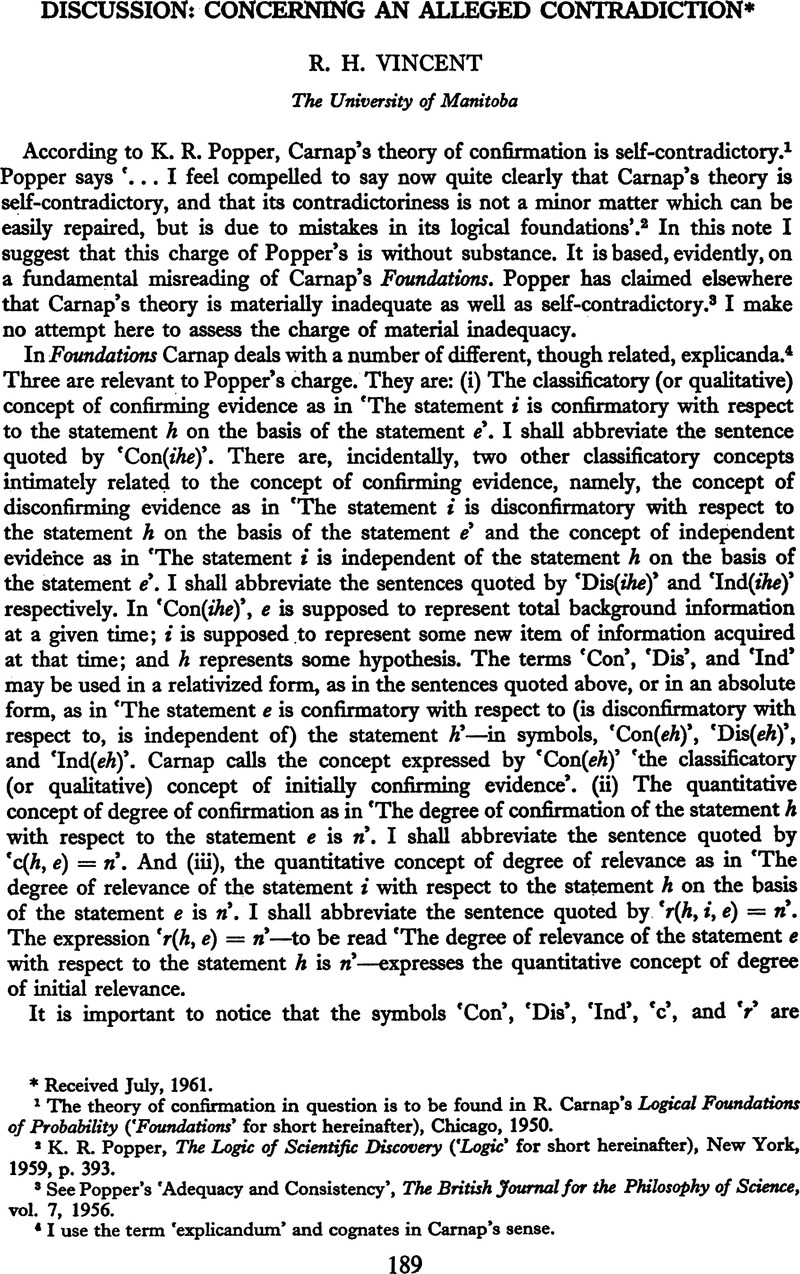Article contents
Discussion: Concerning an Alleged Contradiction
Published online by Cambridge University Press: 14 March 2022
Abstract

- Type
- Discussion
- Information
- Copyright
- Copyright © Philosophy of Science Association 1963
References
1 The theory of confirmation in question is to be found in R. Carnap's Logical Foundations of Probability (‘Foundations’ for short hereinafter), Chicago, 1950.
2 K. R. Popper, The Logic of Scientific Discovery (‘Logic’ for short hereinafter), New York, 1959, p. 393.
3 See Popper's ‘Adequacy and Consistency’, The British Journal for the Philosophy of Science, vol. 7, 1956.
4 I use the term ‘explicandum’ and cognates in Carnap's sense.
5 J. G. Kemeny (Journal of Symbolic Logic, vol. 20, p. 394) and Y. Bar-Hillel (The British Journal for the Philosophy of Science, vol. 7, p. 246) maintain that Carnap and Popper have different explicanda in mind even though each expresses his explicandum by the same words, namely, by ‘degree of confirmation’. Popper disagrees and claims that in Foundations Carnap confuses his own chief explicandum with another. See Logic, p. 393. Kemeny and P. Oppenheim (‘Degree of Factual Support’, this Journal, vol. 19) and H. Leblanc (The British Journal for the Philosophy of Science, vol. 10, p. 313) say that Carnap's chief explicandum is poorly christened ‘the concept of degree of confirmation’. Kemeny suggests ‘the concept of degree of credibility’ instead. Bar-Hillel (op. cit.) thinks that the concept expressed by Carnap by ‘degree of relevance’ is best expressed by ‘degree of confirmation’. Kemeny and Bar-Hillel both agree that Popper's concept of degree of confirmation is akin to Carnap's concept of degree of relevance.
The question whether ‘c’ and ‘C’ express the same concept is not easy to answer. The difficulty is that both writers are guilty of failure to give detailed-enough explanations of their chief explicanda. The difficulty is made worse because both writers provide a plurality of apparently non-equivalent explanations and yet do not make clear which explanation is supposed to be the chief one.
No matter whether ‘c’ and ‘C’ are synonymous, there is a substantive disagreement between Carnap and Popper. Popper maintains that his C(h, e) measures degree of acceptability (or rationality) of belief in h given the information e (provided the information e results from sincere, igenious, and severe tests of h)—see Logic, Appendix ix—and Carnap views his ‘c(h, e)’ as a pre-analytic synonym of ‘degree of rationality of belief in h given the information e’. Carnap's explication of ‘c’ and Popper's of ‘C’ are, however, incompatible. This incompatibility represents a substantive disagreement between Carnap and Popper.
6 See Foundations, p. 563 and references contained therein, for an explanation of ‘c∗’.
7 Carnap's explications of ‘Dis’ and ‘Ind’ are: ‘Dis(ihe)’ for ‘c∗(h, ie) < c ∗(h, e)’ and ‘Ind(ihe)’ for ‘c’(h, ie) = c∗(h, e)’. The absolute forms of ‘Dis’ and ‘Ind’ are explicated analogously.
8 The ensuing argument is to be found in Logic, pp. 390–391. I replace Popper's ‘p’ by Carnap's ‘c∗’. The argument was not devised originally merely to show that Carnap's theory of confirmation is self-contradictory. Popper was originally after bigger game. His argument was designed to show that the statement ‘C(h, e) = p(h, e) for all statements e and h’, where ‘p’ expresses any probability function the arguments of which are statements or propositions, is false.
9 Carnap would accept (4) only if certain conditions are placed on the statement variables therein. For example, it is necessary that the statements e and h be statements from one of the artificial languages that Carnap outlines in Foundations, that e not be logically false, etc. But these are details and do not affect Popper's argument. They may be safely ignored here.
10 To say that ‘Con’, ‘Dis’, and ‘Ind’ are qualitative counterparts of ‘c’, or, that ‘c’ is a quantitative counterpart of ‘Con’, ‘Dis’, and ‘Ind’, is to say that (i) ‘Con’, ‘Dis’, and ‘Ind’ are exclusive and exhautive and (ii) for any statements h 1, h 2, h 3, e 1, e 2, and e 3 if Con(e 1 h 1) and Ind(e 2 h 2) and Dis(e 3 h 3) then c(h 1, e 1) > c(h 2, e 2) > c(h 3, e 3). To say that ‘Con’ is a qualitative counterpart of ‘c’ is to say that ‘Con’ and ‘not-Con’ are qualitative counterparts of ‘c’.
11 Exception for the record: There is a brief mention on p. 476 of Foundations of a term that is perhaps a qualitative counterpart of ‘c’. Carnap is there discussing C. G. Hempel's term ‘confirms’.
Although Carnap does not discuss qualitative counterparts of ‘c’, they are easy to devise. The pre-analytic terms ‘is likely’, ‘is unlikely’, and ‘is neutral’, as defined below, fill the bill: D1 h is likely with respect to e = df c(h, e) > c(not-h, e)
D2 h is unlikely with respect to e = df c(h, e) < c(not-h, e)
D3 h is neutral with respect to e = df c(h, e) = c(not-h, e).
12 Popper, Logic, p. 393.
13 Popper, Logic, p. 399. The italics are Popper's.
- 1
- Cited by




